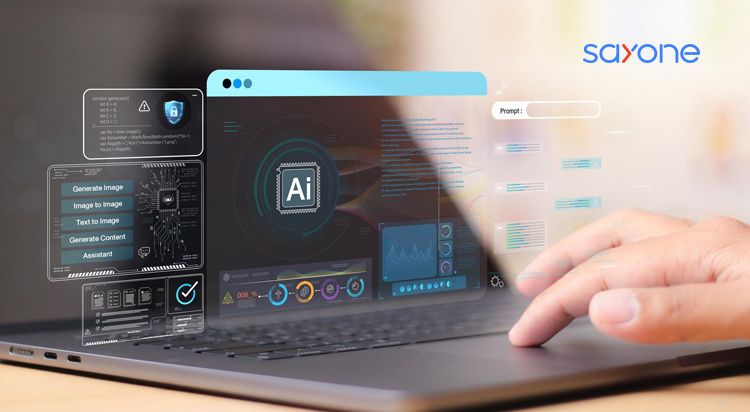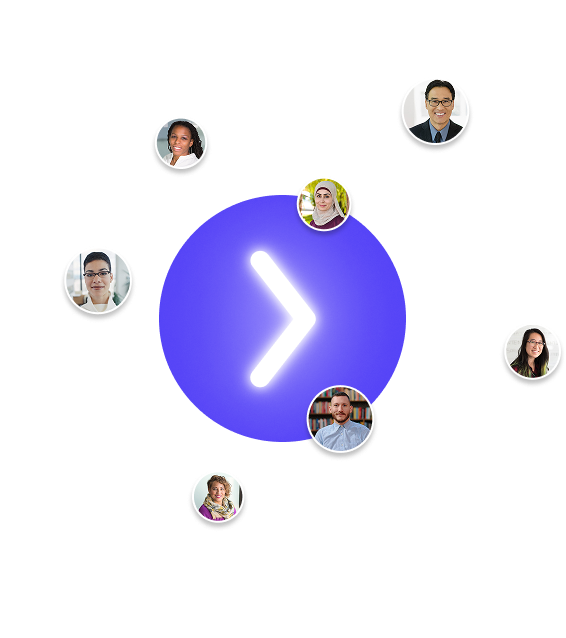
Subscribe to our Blog
We're committed to your privacy. SayOne uses the information you provide to us to contact you about our relevant content, products, and services. check out our privacy policy.

Hari KrishnaJanuary 9, 202511 min read

Generating table of contents...
AI is reshaping web development practices, with industry data showing 37.3% annual growth from 2023 to 2030. Development teams have seen a 45% increase in productivity through automated coding and improved workflows.
More than half of web designers now use AI tools for page creation and design refinement, showing widespread technology adoption across the industry.
The integration of AI brings measurable improvements to web applications. Advanced monitoring systems analyze user behavior patterns, while intelligent algorithms adjust server resources during high-traffic periods.
Studies demonstrate that AI-driven page component optimization leads to 15% better conversion rates. Through real-time data processing and performance tracking, AI systems maintain website speed and responsiveness while managing large-scale operations effectively.
This technological advancement helps businesses build sophisticated, user-focused web applications that adapt to increasing demands. AI tools speed up development cycles and deliver higher quality results through automated testing and continuous performance improvements.
AI in web development combines artificial intelligence with standard web development methods, creating advanced systems for building and maintaining websites.
This approach produces intelligent, automated processes that improve user experiences.
Web development has progressed from basic HTML pages to AI-driven platforms with learning and adaptation capabilities. Now you can simply use an AI website generator to create a fully functional website in a fraction of the time.
Three main technologies form its base:
Checkout the Difference between AI and Machine Learning
These technologies work together to build web solutions that respond to user behavior, handle repetitive tasks automatically, and create personalized experiences.
Modern AI web development uses popular frameworks for browser-based machine learning, OpenAI's GPT for text processing, Generative AI using LLM in Software Development and specialized libraries for image recognition.
Generative AI can be used in software development with other popular languages, Developers can build applications like AI chatbots, Retail AI applications and data-driven predictions.
Key components include:
Successful AI integration in web development requires balanced automated systems with human guidance.
Development teams incorporate AI code generators, behavioral analysis models, and automated testing tools.

Image Source: GenAI used to create architectural designs
The focus remains on maintaining equilibrium between machine automation and human innovation, using AI to support rather than replace developers' expertise.
AI in modern web development has created new standards for building and maintaining digital solutions.
Advanced development methods now shape multiple aspects of web creation.
Teams use AI-powered automation to reduce project timelines. Code generation tools and smart debugging systems remove repetitive tasks, freeing developers to solve complex problems and innovate.
A leading tech company implemented AI-assisted development tools, cutting their deployment cycle while maintaining high code quality.
Can AI completely replace human developers in web development projects?
No, AI serves as a powerful support tool rather than a replacement. While AI excels at automating routine tasks and generating basic code, human developers are needed for complex problem-solving, creative design decisions, and understanding business requirements. Success comes from combining AI's speed with human creativity and strategic thinking.
AI automation has improved resource allocation and development costs. AI-driven testing and quality assurance finds bugs before deployment, reducing post-launch fixes and total development expenses.
AI systems process millions of data points to produce actionable insights. These tools help predict user patterns and refine website features based on actual user behavior, leading to better business outcomes and improved conversion rates.
AI solutions automatically adjust computing power based on traffic needs. This approach prevents slowdowns during busy periods and reduces costs during quiet times, ensuring consistent performance regardless of user load.
Key Benefits for Business Growth
1. Operational Excellence:
2. Performance Management:
3. User Experience Improvements:
Modern AI solutions are reshaping development workflows into intelligent, automated processes, changing how developers work with advanced and accessible tools.
AI coding assistants now exceed basic autocomplete functions. Advanced language models read context, semantic relationships, and coding patterns across multiple programming languages.
Image Source: Programmers who used AI could code 126% more projects per week
These tools generate complete functions, fix complex issues, and suggest architectural improvements, cutting development time by up to 65% while maintaining code quality.
AI-powered testing frameworks use machine learning algorithms for independent test execution and self-correcting scripts.
The tools create test cases, identify potential failure points, and adjust to UI changes automatically.
Visual regression testing combined with smart test prioritization provides thorough coverage while reducing testing cycles by up to 40%.
AI design tools have advanced from simple layout suggestions to complete design systems that process brand guidelines, accessibility requirements, and user behavior patterns.
These platforms create responsive components, refine assets, and anticipate user interactions to build more natural interfaces.
AI optimization tools apply deep learning to examine application behavior, find bottlenecks, and implement performance fixes.
The systems forecast resource usage patterns, improve database queries, and adjust infrastructure as needed, maintaining peak performance under varying loads.
What's the main hurdle when adding AI tools to web development?
Data safety stands as the biggest concern when using AI in web development. Companies must protect business data and user details while using AI systems.
After recent AI platform data breaches, businesses are careful with their private information. Solutions include running AI models on private servers, using strong data protection, and following privacy laws while keeping data anonymous.
AI is reshaping front-end development by automating repetitive tasks and enabling smarter, user-focused designs. It allows developers to concentrate on creativity while AI handles routine processes, improving workflows and delivering personalized experiences that drive business outcomes.
Repetitive coding tasks often slow down project timelines. AI tools like GitHub Copilot generate code snippets, automate debugging, and assist with testing processes. For businesses, this translates to faster project delivery and reduced development costs.
How does AI improve productivity in front-end development?
AI improves productivity by automating routine tasks like code writing and layout adjustments. This allows developers to focus on innovation and problem-solving, accelerating project timelines and improving the quality of the final product.

Image Source: AI integration for theme generation to componentization to code to multiple platforms
Maintaining consistent designs across platforms can be challenging. AI tools analyze user behavior to adjust layouts and interfaces dynamically, creating user-friendly experiences. Businesses can use this to build trust and improve usability.
Generic user experiences often fail to engage customers. AI enables real-time personalization by analyzing user preferences and behavior, delivering tailored content that increases engagement and drives conversions—an essential strategy for scaling businesses in competitive markets.
AI in backend development changes how web applications process data, protect systems, and grow with demand.
Companies now use AI-powered backend systems to run complex tasks automatically and create better user experiences through smart data handling and instant optimization.
Backend development often includes many repeated coding tasks that delay project completion.
AI tools can create code snippets, run tests, and find bugs before they affect live systems. These advanced systems cut development time while maintaining high code quality and consistent standards across projects.
AI-powered backend systems track usage patterns and adjust resources automatically.
Smart prediction tools help applications scale up or down based on demand, keeping performance high during busy periods while reducing costs during quiet times.
Leading services like AWS Amplify and Firebase use these features to manage millions of user requests at once.
AI Security Improvements:
AI changes how designers create user interfaces and experiences. Through machine learning algorithms and predictive analytics, companies build better, personalized digital products while cutting design time.
AI tools like Adobe Sensei and Uizard handle complex tasks from layout adjustments to style matching.
These systems learn from millions of successful designs to recommend color schemes and layouts, letting designers concentrate on creative strategy instead of repetitive work.
AI systems track and respond to user behavior in real-time to deliver custom-fit experiences. Platforms like Dynamic Yield and Optimizely adjust layouts based on user actions, leading to 20-30% higher engagement rates across industries.
AI analytics tools offer clear insights through automated A/B testing and predictive modeling. This helps designers perfect user flows and increase conversion rates using design choices backed by actual user preferences and behaviors.
AI turns website data into clear actions that improve search rankings and user experience. Today's AI tools offer exact performance tracking and automated optimization methods that manual work cannot match. By integrating AI into your strategy, working with an SEO Perth expert can help you maximize the potential of these tools to drive better results and enhance your website's performance.
Business owners face a constant challenge: writing content that works for both search engines and readers.
Here's how AI changes content creation:
Poor performance hurts your site's standing with users and search engines. AI tools watch important metrics like load times, server speed, and user actions. Partnering with an SEO consulting company can help you interpret these insights and implement the right optimizations to boost visibility and user experience.
Image source: Google Pagespeed Insights
Google PageSpeed Insights uses machine learning to spot issues and fix them quickly, keeping your site running at its best.
Each website visitor behaves differently. AI studies these behaviors to create custom experiences for everyone. Take Spotify - their AI personalization led to 40% more user activity through custom music lists based on listening habits.
Want to know what makes websites succeed? AI analytics process data to find market gaps and ways to improve. These tools predict popular topics, study what competitors do, and show you how to stay current with market changes.
Even with advancements in AI, it still lacks managing the whole SEO of a website. To cope with it, you must get SEO Services from an agency to get the work done.
Are your web applications struggling to meet growing demands for performance and scalability? Staying ahead requires innovative and tailored solutions.
SayOne specializes in crafting AI-driven web development services designed to meet your business needs. With a proven track record, our expert team delivers scalable, high-performance applications that help businesses succeed in competitive markets. SayOne is your trusted partner for creating future-ready web solutions.
Ready to elevate your web development with AI? Contact SayOne today to discuss your project requirements.

We're committed to your privacy. SayOne uses the information you provide to us to contact you about our relevant content, products, and services. check out our privacy policy.

About Author
Helping Companies Scale Tech Teams 2X Faster with Pre-Vetted Talent | Contract Hiring & Resource Augmentation | Cutting Hiring Costs by 40%

We collaborate with visionary leaders on projects that focus on quality